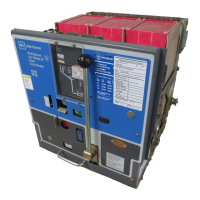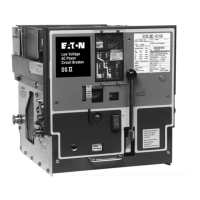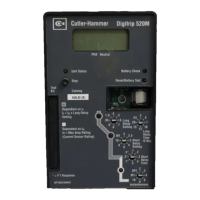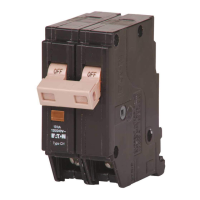1.8. 33-790-11
The standard control utilizes AC
or
DC control power. For
240
or
120 volt
AC
equipment, the control power may be
taken direct from the source through fuses. For 480 and
600 volt operation, a suitable control power transformer
is used. The transformer is optional for 240 volt systems.
DC
control voltages are 48, 125
or
250.
When the breaker closed, the "a" contact
in
the shunt trip
(SH-TR) coil circuit also closed to complete this trip cir-
cuit. The red indicating lamp (R) supervises the shunt trip
circuit to show that it is
in
working order, and indicates
that the breaker is closed.
When control power is turned on, any power-operated
breaker in the test or connected position with its springs
discharged will have its motor energized until the closing
springs are charged.
5.1.3 Manual-Operated Mechanisms
On manually operated breakers, the closing spring can
be charged only by hand, as described
in
Section 4.2. As
usually equipped, the breaker can be closed only by
hand, with the close bar. As an optional extra, a closing
spring release device can be supplied on these breakers.
Hand opening
of
the breaker can be done only by means
of
the trip plate; however a shunt trip device can be sup-
plied as an optional extra.
5.1.4 Explanation
of
Spring-Charging Mechanism for
Manually-Operated Breakers
Figure 20 is another isometric diagram to illustrate the
mechanism
in
a manually operated breaker. For sake
of
clarity, the actuator has been omitted.
Figure
21
gives the details
of
this spring-charging device
which is located between the mechanism right hand side
frame and the right crank arm. A part
of
this assembly is
the manual charge cam which is rigidly fixed to the crank
shaft, the same
as
the main close cam and crank arms.
The other parts are the front crank assembly which is piv-
oted to a bracket fastened to the main frame base, and
has a socket for the manual charge handle. The rear
crank is pivoted to the front portion and has a cross-wise
pin on the end. A spring forces this pin against the cam.
Another spring holds the front crank assembly
in
a clock-
wise direction against a stop, so that the manual
spring-charge handle socket is normally upright
in
the
unused position.
Effective October 1998
Page 23
1. Manual Charge Handle
2.
Manual Charge Handle
Socket
rn
'
3.
Front
Ci-ank Assembly
4.
Pivot Pin
; 5. Mounting Bracket
I
I
1
6.
Rear Crank Assembly
1 I 7. Crank
Piri
8. Manual Charge Cams (3)
:
9.
Crank Shaft
I
.ir.=
.........
--1
o_._c•aw
Stop
Fig.
21
Spring-Charging Mechanism on Manual
Operated Breakers
The manual charge cam is mounted on the crank shaft
so that the crank pin hooks behind the hook-shaped sur-
face
of
the manual charge cam as shown, when the han-
dle is upright and the springs discharged. The springs are
fully charged by a 90 degree counterclockwise rotation
of
the handle. The crank spring then returns the assembly
to the handle-upright position.
In
operation this means a
single downward stroke from vertical to approximately
the horizontal position.
As
the "Spring charged" position
is reached, the handle becomes effortless to turn and the
closing
spring crank arms snap over center.
It is possible to manually recharge the closing springs
immediately after closing the breaker and before it has
been tripped open. This results
in
the springs loading the
associated bearings and latches for long periods. Also an
extra close operation,
or
trip-free operation, will be nec-
essary on levering the breaker to the disconnect and
remove positions. Therefore, it is recommended that the
springs be charged
just
prior to the closing
of
the
breaker.
Courtesy of NationalSwitchgear.com

